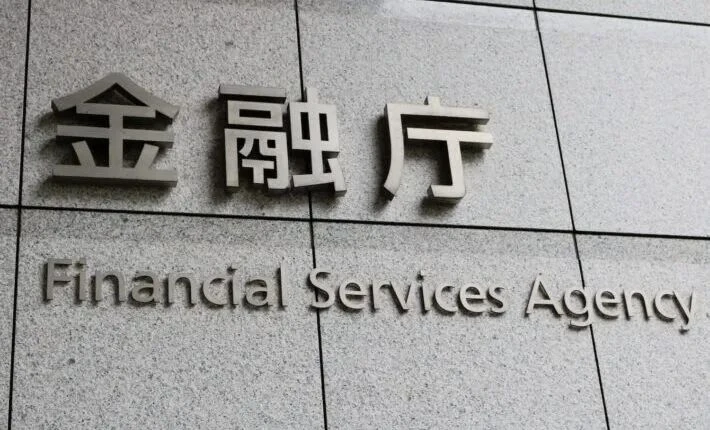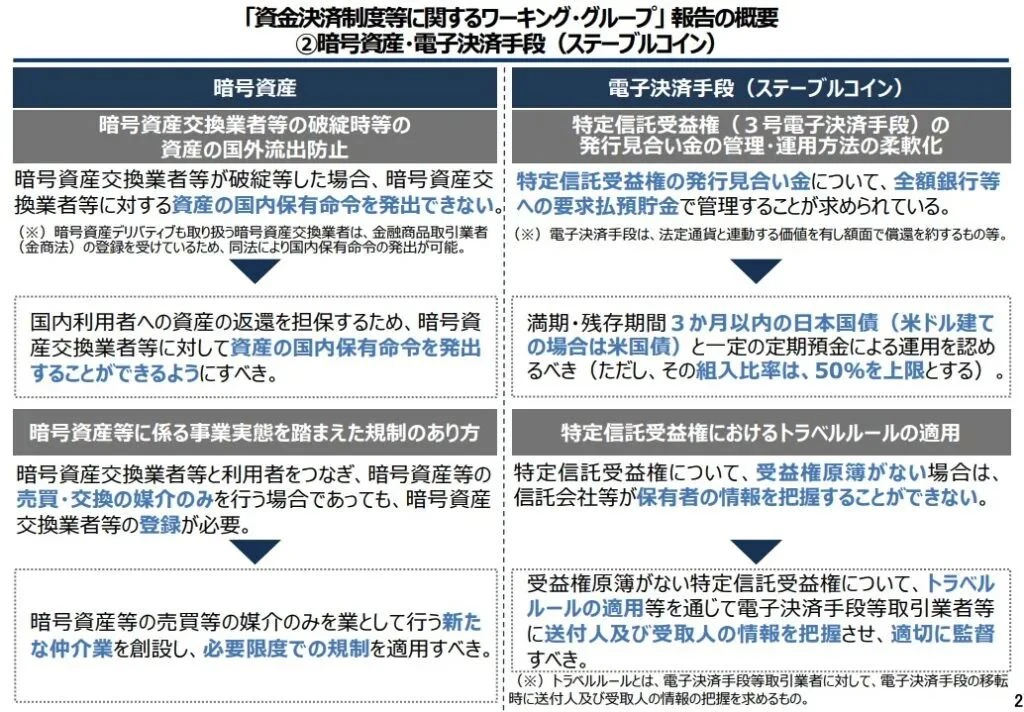On February 19, 2024, the Financial Services Agency (FSA) of Japan approved the "Report of the Working Group on Payment Settlement Systems" at the General Meeting of the Financial Review Board, chaired by Hiroyuki Kamizawa.
This report is the final outcome formed after seven rounds of discussions in response to a consultation request from the Minister of Finance in August 2024. The core content of the report involves a new regulatory framework for cryptocurrencies (virtual currencies) and stablecoins, specifically providing concrete suggestions on user protection during exchange bankruptcies, the establishment of intermediary businesses, and the asset utilization rules for stablecoins. This policy direction marks a further refinement of Japan's regulation in the cryptocurrency and stablecoin sectors, aiming to balance innovation with risk control.

This article will provide an in-depth interpretation of this new regulatory framework from four aspects: policy background, main content, policy impact, and future outlook.
I. Policy Background: FTX Bankruptcy and User Protection Needs
In November 2022, the bankruptcy of FTX, the world's second-largest cryptocurrency exchange, shocked the entire cryptocurrency industry. The collapse of FTX not only resulted in the loss of billions of dollars in user assets but also exposed the weak links in the regulation of cryptocurrency exchanges. As a significant player in the global cryptocurrency market, Japan's regulatory body, the FSA, quickly responded by re-evaluating the shortcomings of the existing regulatory framework.
Japan had already included cryptocurrencies under regulation with the "Payment Services Act" in 2017 and established a relatively complete exchange licensing system. However, the FTX incident indicated that existing regulatory measures were still insufficient to address extreme situations such as exchange bankruptcies. Therefore, the FSA initiated a new round of regulatory reforms in 2024, aiming to strengthen user protection and enhance market transparency.
II. Main Content of the New Regulatory Framework
1. Strengthening User Protection During Exchange Bankruptcies
The report proposes to introduce new provisions in the "Payment Services Act" based on relevant regulations of the "Financial Instruments and Exchange Act" to enhance user protection during cryptocurrency exchange bankruptcies. Specific measures may include:
Asset segregation requirements: Requiring exchanges to strictly separate user assets from their own assets to prevent user assets from being used to repay debts in the event of bankruptcy.
Priority of claims in bankruptcy liquidation: Clarifying users' priority rights in bankruptcy liquidation to ensure that user assets can be returned first.
Disclosure obligations: Requiring exchanges to regularly disclose their financial status and asset custody conditions to enhance transparency.
These measures aim to prevent a recurrence of incidents like FTX and provide users with a safer trading environment.

Excerpt from the Financial Review Board's "Report on the Working Group on Payment Settlement Systems"
2. Establishment of Cryptocurrency Intermediary Businesses
The report also proposes a new business model—cryptocurrency trading intermediary services. These intermediary institutions will adopt a "belonging system," meaning they must be affiliated with a specific exchange to conduct business. Unlike traditional exchanges, intermediary institutions do not directly hold user assets, resulting in relatively relaxed regulatory requirements:
No asset custody obligations: Intermediary institutions do not directly hold user assets, reducing the risk of fund misappropriation or loss.
Simplified entry conditions: Intermediary institutions are not required to meet strict asset base requirements and do not bear direct obligations for anti-money laundering (AML) and combating the financing of terrorism (CFT).
Limited scope of business: Intermediary institutions are only responsible for matching buy and sell orders and do not engage in complex businesses such as asset custody or clearing.
The establishment of this new business model aims to lower market entry barriers, promote market competition, and ensure compliance of intermediary institutions through the "belonging system."
3. Adjustment of Asset Utilization Rules for Stablecoins
The report proposes significant adjustments to the asset utilization rules for stablecoins. According to current regulations, stablecoin issuers must deposit equivalent assets in the form of "demand deposits" at banks. The new framework allows issuers to use a portion of their assets for low-risk financial products such as short-term government bonds and time deposits:
New asset categories: Allowing stablecoin issuers to invest no more than 50% of their assets in short-term government bonds and time deposits.
Risk control: Setting a 50% cap on the proportion of the new asset categories to ensure that the asset reserves of stablecoins have sufficient liquidity.
This adjustment aims to improve the asset utilization efficiency of stablecoin issuers while controlling risks through proportional limits.
III. Policy Impact Analysis
1. Impact on Users
The biggest beneficiaries of the new regulatory framework are ordinary users. By strengthening user protection measures during exchange bankruptcies, the security of user assets will be significantly enhanced. Additionally, the establishment of intermediary businesses may lower transaction costs and provide users with more choices.
2. Impact on Exchanges and Intermediary Institutions
For exchanges, the new regulations will increase their compliance costs, particularly regarding asset segregation and disclosure requirements. However, these measures will also help enhance the credibility of exchanges and attract more users. For intermediary institutions, the establishment of this new business model provides opportunities for small and medium-sized enterprises to enter the market, but the "belonging system" also means their business independence is limited.
3. Impact on the Stablecoin Market
The adjustment of asset utilization rules for stablecoins will improve the asset yield of issuers, thereby enhancing their profitability. However, the 50% cap also limits the risk-bearing capacity of issuers, ensuring that the stability of stablecoins is not compromised.
4. Impact on Japan's Cryptocurrency Market
The new regulatory framework further solidifies Japan's position as a global leader in cryptocurrency regulation. By balancing innovation and risk control, Japan is expected to attract more international capital and projects into its market.
IV. Future Outlook
With the implementation of the user protection measures proposed by the FSA, Web3 security compliance companies like Beosin play a crucial role in this process. Beosin focuses on security compliance in the cryptocurrency asset industry, providing comprehensive smart contract security audits and compliance services. Through this technical support, cryptocurrency service providers can operate within a compliance framework, effectively preventing potential security risks.
The new regulatory framework approved by Japan's FSA marks a new stage in the regulation of cryptocurrencies and stablecoins. However, with the rapid development of technology and the continuous changes in the market, regulatory agencies must remain flexible and respond promptly to emerging risks.
Possible future directions include:
Cross-border regulatory cooperation: The globalization of the cryptocurrency market requires regulatory agencies in various countries to strengthen cooperation and establish unified regulatory standards.
Technology-driven regulation: Utilizing blockchain technology and artificial intelligence tools to enhance regulatory efficiency and transparency.
User education: Strengthening the dissemination of cryptocurrency knowledge to ordinary users, improving their risk awareness and self-protection capabilities.
The new regulatory framework approved by Japan's FSA is an important milestone in the regulation of cryptocurrencies and stablecoins. By strengthening user protection, establishing intermediary businesses, and adjusting stablecoin asset utilization rules, Japan is promoting market innovation while providing important references for global cryptocurrency regulation. In the future, with the gradual implementation of this framework, Japan is expected to occupy a more significant position in the global cryptocurrency market.
免责声明:本文章仅代表作者个人观点,不代表本平台的立场和观点。本文章仅供信息分享,不构成对任何人的任何投资建议。用户与作者之间的任何争议,与本平台无关。如网页中刊载的文章或图片涉及侵权,请提供相关的权利证明和身份证明发送邮件到support@aicoin.com,本平台相关工作人员将会进行核查。




